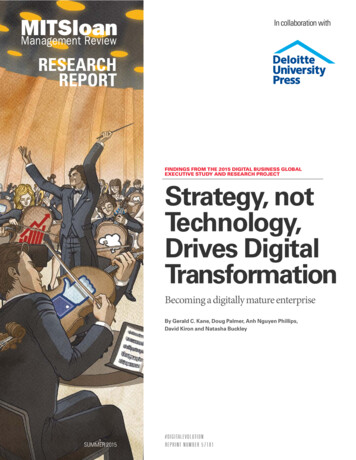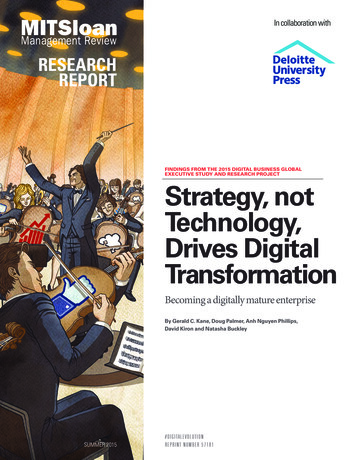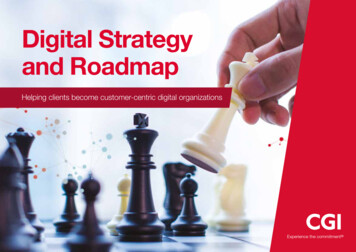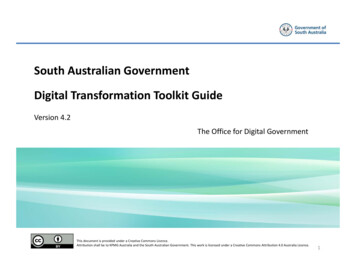
Transcription
In collaboration withRESEARCHREPORTFINDINGS FROM THE 2015 DIGITAL BUSINESS GLOBALEXECUTIVE STUDY AND RESEARCH PROJECTStrategy, notTechnology,Drives DigitalTransformationBecoming a digitally mature enterpriseBy Gerald C. Kane, Doug Palmer, Anh Nguyen Phillips,David Kiron and Natasha BuckleySUMMER 2015# D I G I TA L E V O L U T I O NREPRINT NUMBER 57181
R E S E A R C H R E P O R T S T R AT E G Y, N O T T E C H N O L O G Y, D R I V E S D I G I TA L T R A N S F O R M AT I O NAUTHORSGERALD C. KANE is the MIT Sloan ManagementReview guest editor for the Digital TransformationStrategy Initiative.DAVID KIRON is the executive editor of the BigIdeas Initiatives at MIT Sloan Management Review,which brings ideas from the world of thinkers tothe executives and managers who use them.DOUG PALMER is is a principal in the DigitalBusiness and Strategy practice of Deloitte Digital.ANH NGUYEN PHILLIPS is a senior manager withinNATASHA BUCKLEY is a senior manager withinDeloitte Services LP, where she researches emerging topics in the business technology market.Deloitte Services LP, where she leads strategicthought leadership initiatives.CONTRIBUTORSJonathan Copulsky, Carolyn Ann Geason, Nidal Haddad, Nina Kruschwitz, Daniel Rimm, Ed RuehleTo cite this report, please use:G. C. Kane, D. Palmer, A. N. Phillips, D. Kiron and N. Buckley, “Strategy, Not Technology, Drives DigitalTransformation” MIT Sloan Management Review and Deloitte University Press, July 2015.Copyright MIT, 2015. All rights reserved.Get more on digital leadership from MIT Sloan Management Review:Read the report online at http://sloanreview.mit.edu/digital2015Visit our site at http://sloanreview.mit.edu/topic/digitalGet the free digital leadership enewsletter at http://sloanreview.mit.edu/enews-digitalContact us to get permission to distribute or copy this report at smr-help@mit.edu or 877-727-7170
CONTENTSRESEARCHREPORTSUMMER 20153 / Executive Summary4 / Introduction: DigitalTransformation Isn’tReally About Technology5 / Digital Strategies ThatTransform Creating a Strategy ThatTransforms The Talent Challenge12 / Leading the DigitalTransformation14 / Conclusion: TheContours of the EndState16 / Acknowledgments17 / Appendix: SurveyQuestions and Answers9 / The Culture of DigitalBusiness Transformation Taking Risks Becomes aCultural Norm Sparking New Ideas Telling the Story Can Technology Change theCulture?STRATEGY, NOT TECHNOLOGY, DRIVES DIGITAL TRANSFORMATION MIT SLOAN MANAGEMENT REVIEW 1
Strategy, notTechnology,Drives DigitalTransformationMExecutive SummaryIT Sloan Management Review and Deloitte’s1 2015 global study of digitalbusiness found that maturing digital businesses are focused on integratingdigital technologies, such as social, mobile, analytics and cloud, in theservice of transforming how their businesses work. Less-mature digitalbusinesses are focused on solving discrete business problems withindividual digital technologies.The ability to digitally reimagine the business is determined in large part by a clear digital strategysupported by leaders who foster a culture able to change and invent the new. While these insightsare consistent with prior technology evolutions, what is unique to digital transformation is that risktaking is becoming a cultural norm as more digitally advanced companies seek new levels of competitive advantage. Equally important, employees across all age groups want to work for businessesthat are deeply committed to digital progress. Company leaders need to bear this in mind in order toattract and retain the best talent.The following are highlights of our findings:Digital strategy drives digital maturity. Only 15% of respondents from companies at the earlystages of what we call digital maturity — an organization where digital has transformed processes,talent engagement and business models — say that their organizations have a clear and coherentdigital strategy. Among the digitally maturing, more than 80% do.The power of a digital transformation strategy lies in its scope and objectives. Less digitally mature organizations tend to focus on individual technologies and have strategies that are decidedlyoperational in focus. Digital strategies in the most mature organizations are developed with an eyeon transforming the business.STRATEGY, NOT TECHNOLOGY, DRIVES DIGITAL TRANSFORMATION MIT SLOAN MANAGEMENT REVIEW 3
R E S E A R C H R E P O R T S T R AT E G Y, N O T T E C H N O L O G Y, D R I V E S D I G I TA L T R A N S F O R M AT I O NMaturing digital organizations build skills to realize the strategy. Digitally maturing organizationsare four times more likely to provide employees withneeded skills than are organizations at lower ends ofthe spectrum. Consistent with our overall findings,the ability to conceptualize how digital technologiescan impact the business is a skill lacking in manycompanies at the early stages of digital maturity.Employees want to work for digital leaders. Acrossage groups from 22 to 60, the vast majority of respondents want to work for digitally enabled organizations.Employees will be on the lookout for the best digitalopportunities, and businesses will have to continuallyup their digital game to retain and attract them.Taking risks becomes a cultural norm. Digitallymaturing organizations are more comfortable taking risks than their less digitally mature peers. Tomake their organizations less risk averse, businessleaders have to embrace failure as a prerequisite forsuccess. They must also address the likelihood thatemployees may be just as risk averse as their managers and will need support to become bolder.ABOUT THE RESEARCHTo understand the challenges and opportunities associated with theuse of social and digital business, MIT Sloan Management Review,in collaboration with Deloitte, conducted its fourth annual survey ofmore than 4,800 business executives, managers and analysts fromorganizations around the world. The survey, conducted in the fall of2014, captured insights from individuals in 129 countries and 27industries and involved organizations of various sizes. The samplewas drawn from a number of sources, including MIT alumni, MITSloan Management Review subscribers, Deloitte Dbriefs webcastsubscribers and other interested parties. In addition to our surveyresults, we interviewed business executives from a number ofindustries, as well as technology vendors, to understand thepractical issues facing organizations today. Their insights contributedto a richer understanding of the data. Surveys in the three previousyears were conducted with a focus on social business. This year’sstudy has expanded to include digital business.4 MIT SLOAN MANAGEMENT REVIEW DELOITTE UNIVERSITY PRESSThe digital agenda is led from the top. Maturingorganizations are nearly twice as likely as less digitally mature entities to have a single person or groupleading the effort. In addition, employees in digitallymaturing organizations are highly confident in theirleaders’ digital fluency. Digital fluency, however,doesn’t demand mastery of the technologies. Instead,it requires the ability to articulate the value of digitaltechnologies to the organization’s future.Introduction: DigitalTransformation Isn’t ReallyAbout TechnologyOne wouldn’t expect that changing the size of tablesin an employee cafeteria could be emblematic of thedigital transformation of a business. But consider thisexample: The tables in question were in the offices of alarge, online travel company working with Humanyze,a people-analytics company headquartered in Bostonthat is a spinoff of the MIT Media Lab. Humanyze integrates wearables, sensors, digital data and analyticsto identify who talks to whom, where they spend timeand how they talk to each other. The analysis identifies patterns of collaboration that correlate with highemployee productivity.Humanyze analyzed the travel company’s workforceand discovered that people eating lunch togethershared important insights that made them moreproductive. In addition, the analysis showed thatproductivity went up based on the number of peopleat the same table. At the company being analyzed,Humanyze found that employees typically lunchedwith either four or 12 people. A quick inspection ofthe cafeteria solved the puzzle — all the tables werefor either four or 12 people. The integration of digital technologies pointed the way to increasing tablesizes, which had a direct and measurable impact onemployees’ ability to produce.The tale of the tables is a powerful example of a keyfinding in this year’s MIT Sloan Management Reviewand Deloitte digital business study: The strength ofdigital technologies — social, mobile, analytics and
FIGURE 1: To assess companies’ digital maturity, we askedrespondents to rate their company against an ideal organization —one transformed by digital technologies and capabilities — on a scaleof 1 to 10. Three groups emerged: “early” (1–3), “developing” (4–6)and “maturing” (7–10).cloud — doesn’t lie in the technologies individually.Instead, it stems from how companies integrate themto transform their businesses and how they work.Another key finding: What separates digital leadersfrom the rest is a clear digital strategy combined with aculture and leadership poised to drive the transformation. The history of technological advance in businessis littered with examples of companies focusing on technologies without investing in organizational capabilitiesthat ensure their impact. In many companies, the failedimplementation of enterprise resource planning andprevious generations of knowledge management systems are classic examples of expectations falling shortbecause organizations didn’t change mindsets and processes or build cultures that fostered change. Our reportlast year on social business found similar shortcomingsstanding in the way of technology reaching its potential.2Our findings this year are based on an assessmentof digital business maturity and how maturing organizations differ from others. To assess maturity, we askedrespondents to “imagine an ideal organization transformed by digital technologies and capabilities thatimprove processes, engage talent across the organization and drive new value-generating business models.”(See “About the Research,” page 4.) We then askedthem to rate their company against that ideal on a scaleof 1 to 10. Three groups emerged: “early” (26%), “developing” (45%) and “maturing” (29%). (See Figure 1.)Although we found some differences in technologyuse between different levels of maturity, we found thatas organizations mature, they develop the four technologies (social, mobile, analytics and cloud) in nearequal measure. The greatest differences between levelsof maturity lie in the business aspects of the organization. Digitally maturing companies, for example, aremore than five times more likely to have a clear digitalstrategy than are companies in early stages. Digitallymaturing organizations are also much more likely tohave collaborative cultures that encourage risk taking.Several obstacles stand in the way of digital maturity;lack of strategy and competing priorities lead the listof speed bumps. Lack of a digital strategy is the biggest barrier to digital maturity for companies in theEarly(1-3)Maturing(7-10)26%17%15%14% Maturing12%6 7 8 9 102 3 4 5Organization’s digital maturity levelFIGURE 2: While a lack of strategy hinders early anddeveloping companies, security issues become a greaterconcern for maturing digital companies.26%45%29%EarlyDevelopingMaturing1. Lack of strategy1. Too many prioritiesTop Barriers2. Lack of strategyby Maturity 2. Too many prioritiesStage3. Lack of management 3. Insufficient tech skillsunderstanding1. Too many priorities2. Security concerns3. Insufficient tech skillsearly stages, according to more than 50% of respondents from early-stage organizations. As companiesmove up the maturity curve, competing prioritiesand concerns over digital security become the primary obstacles. (See Figure 2.)Across the board, respondents agree that the digitalage is upon us: Fully 76% of respondents say thatdigital technologies are important to their organizations today, and 92% say they will be importantthree years from now. In this year’s report, which isbased on a survey of more than 4,800 executives andmanagers as well as interviews with business andthought leaders, we look specifically at the emergingcontours of digital business and how companies aremoving forward with their digital transformations.Digital Strategies ThatTransformTo a great extent, digital strategy drives digital maturity. Only 15% of respondents from companies at theSTRATEGY, NOT TECHNOLOGY, DRIVES DIGITAL TRANSFORMATION MIT SLOAN MANAGEMENT REVIEW 5
R E S E A R C H R E P O R T S T R AT E G Y, N O T T E C H N O L O G Y, D R I V E S D I G I TA L T R A N S F O R M AT I O Nearly stages say that their organizations have a clearand coherent digital strategy. (See Figure 3.) Amongthe more digitally mature, the number leaps to 81%.Effectively communicating strategy is equally important, and maturing companies excel at it. Amongrespondents from companies at early stages, 63%agree or strongly agree that they know what theircompanies are doing in the digital domain. In maturing organizations, 90% do.FIGURE 3: A digitally maturing organization follows a clear andcoherent digital strategy and effectively communicates it to employees.81%“Our organization has aclear and coherent digitalstrategy.” (Respondentswho answered “Stronglyagree” or ion’s digital maturity levelFIGURE 4: Organizations across the board are using digital to improveefficiency and the customer experience, but higher-maturity organizations differentiate themselves by using digital to transform theirbusiness, allowing them to move ahead of the competition.To what extent do you agree that the following areobjectives of your organization's digital strategy?(Respondents who answered “Strongly agree” or “Agree”)Percentage of respondents agreeing100%Improve customerexperience andengagement80%Increase efficiencyImprove businessdecision making60%Improve innovation40%Transform the businessThe ultimate power of a digital strategy lies in itsscope and objectives. In his oft-cited 2003 HarvardBusiness Review article, “IT Doesn’t Matter,” NicholasCarr argued that unless a technology is proprietaryto a company, it ultimately won’t provide competitiveadvantage on its own. As was the case with electricity and rail transport, many technologies will becomeavailable to all and thus provide no inherent advantage. The trap to avoid, according to Carr, is focusingon technology as an end in itself. Instead, technologyshould be a means to strategically potent ends.3Our research found that early-stage companies arefalling into the trap of focusing on technology overstrategy. Digital strategies at early-stage entities havea decidedly operational focus. Approximately 80%of respondents from these companies say improvingefficiency and customer experiences are objectivesof their digital strategies. Only 52% say that transforming the business is on the digital docket.In maturing companies, on the other hand, digitaltechnologies are more clearly being used to achievestrategic ends. Nearly 90% of respondents say thatbusiness transformation is a directive of their digitalstrategies. The importance that these organizationsplace on using digital technology to improve innovation and decision making also reflects a broadscope beyond the technologies themselves. In companies with low digital maturity, approximately60% of respondents say that improving innovationand decision making are digital strategy objectives.In digitally maturing organizations, nearly 90% ofstrategies focus on improving decisions and innovation. (See Figure 4.)“Senior leadership must really understand the powerof digital technologies,” says Carlos Dominguez,president and COO of Sprinklr, an enterprise socialtechnology provider. “This is as much a transformation story as it is a technology one.”20%Creating a Strategy That nization’s digital maturity level6 MIT SLOAN MANAGEMENT REVIEW DELOITTE UNIVERSITY PRESSWhen developing a more advanced digital strategy,the best approach may be to turn the traditional strat-
A DIGITAL MCDONALD’SAs it confronts changing consumer tastes, McDonald’s isdigitally revamping its restaurant experience and how thecompany works. The global restaurant chain was one of thefirst companies to adopt the Apple Pay mobile payments solution. Last year, it installed kiosks in select locations thatallow customers to order customized hamburgers. And it’sseeking partnerships with startups, such as a company thatembeds sensors into paper.iMcDonald’s is also integrating digital technologies to spurthe organization to work in new ways. Its ambitious campaign during the 2015 Super Bowl football championship isan excellent example: McDonald’s planned to give away anitem related to every commercial that aired during the game.To respond to commercials almost instantaneously,McDonald’s had to integrate multiple digital technologiesand reconfigure its internal communication and operationalprocesses. The integration came together in a digital newsroom with a cross-functional team that included membersegy development process on its head. Benn Konsynski,the George S. Craft Distinguished University Professorof Information Systems & Operations Managementat Emory University’s Goizueta Business School, proposes that rather than analyzing current capabilitiesand then plotting an organization’s next steps, organizations should work backwards from a future vision.“The future is best seen with a running start,” Konsynski comments. “Ten years ago, we would not havepredicted some of the revolutions in social or analytics by looking at these technologies as they existed atthe time. I would rather start by rethinking businessand commerce and then work backwards. New capabilities make new solutions possible, and neededsolutions stimulate demand for new capabilities.”As an example, Konsynski points to the spice and flavor manufacturer McCormick & Company. Giventhe importance of personalization and digital technology’s ability to provide it, McCormick developedFlavorPrint, an algorithm representing the company’s flavors as a vector of 50 data points. Currently,McCormick uses FlavorPrint to recommend recipesto its consumers. But the vision is much bolder. McCormick thinks of FlavorPrint as the Pandora offrom the company’s marketing and legal divisions, representatives from the company’s various advertising agenciesand employees from the company’s enterprise social technology provider.Meeting the goal required real-time reactions and monitoring and analysis of social media trends. It also demandedon-the-spot decision making to come up with the best decisions about which products to give away. The effort wassuccessful and drew 1.2 million retweets, including somefrom high-profile celebrities such as Taylor Swift.The event was part of an ongoing effort at the fast foodchain to transform itself into an organization that integratestechnologies to become more agile, experimental and collaborative. As Lainey Garcia, manager of brand publicrelations and engagement at McDonald’s, put it: “The biggest takeaway was the power of integration. You canaccomplish amazing things when you have all those piecesworking together collectively in a holistic way.”flavorings, which has prompted the organization tosee itself as a food experience company rather than apurveyor of spices.Eventually, all McCormick flavors will be digitized,and the company will be able to tailor them to regional, cultural and even individual personal tastes.Although all the needed technologies are not yet available, they likely will be in the coming years, and thestrategy to take advantage of them is already in place.The FlavorPrint product has shown such promise thatMcCormick recently spun it off into its own technology company, Vivanda, with former McCormick CIOJerry Wolfe as its founder and CEO.4The Talent ChallengeMaturing digital organizations don’t tolerate skillgaps. More than 75% of respondents from thesecompanies agree or strongly agree that their organizations are able to build the necessary skills tocapitalize on digital trends. Among low-maturity entities, the number plummets to 19%.Consistent with our overall findings, the ability toconceptualize how digital technologies can im-STRATEGY, NOT TECHNOLOGY, DRIVES DIGITAL TRANSFORMATION MIT SLOAN MANAGEMENT REVIEW 7
R E S E A R C H R E P O R T S T R AT E G Y, N O T T E C H N O L O G Y, D R I V E S D I G I TA L T R A N S F O R M AT I O NFIGURE 5: Results from our research suggest companies shouldrethink conventional wisdom and consider the fact that the majorityof their employees across age groups want to work for a digitallyenabled organization.How important to you is it to work for an organization that isdigitally enabled or is a digital leader? (Respondents whoanswered “Very important” or “Extremely important”)Percentage of respondents100%85%83%81%80%80%79%76%72%60%pact the business is a skill lacking in early-stagecompanies. Nearly 60% of respondents from theseorganizations rank ability to conceptualize as one ofthe top three skills that need bolstering. Only 32%of respondents from digitally maturing companiesexpress the same need.The ability to adapt quickly to change also standsout as an important capability. Perry Hewitt, chiefdigital officer at Harvard University, says agility ismore important than technology skills. Emoryprofessor Konsynski concurs: “The 21st century isabout agility, adjustment, adaptation and creatingnew opportunities.”40%20%0%21 oryoungerNo. ofrespondents 24Percentageof total 1%22 to 2728 to 3536 to 4445 to 5253 to 5960 ercentages add to 98%. Remaining 2% chose not to respond to the question.FIGURE 6: Companies in the early stages of digital maturityshould seek opportunities to generate buy-in among employees totheir digital strategy.“I am satisfied with my organization's currentreaction to digital trends.”Percentage of respondents100%Strongly satisfied/satisfied80%60%Employeesare notmerely40% indifferent,they aredissatisfied20%0%Strongly 0MaturingOrganization’s digital maturity level8 MIT SLOAN MANAGEMENT REVIEW DELOITTE UNIVERSITY PRESSTraining to fill skill gaps is increasingly offered onlineand on a just-in-time basis. As part of its new approach to learning, The Walt Disney Co., for example,has implemented a platform that offers video, mobileand digital content to employees as needed. “Three orfour years ago, learning at Disney happened in classrooms,” says Steve Milovich, senior vice president ofglobal human resources and talent diversity, Disney/ABC Television Group and also senior vice presidentof employee digital media, The Walt Disney Company. “Now we offer content such as TED-like talksfeaturing Disney executives that allow employees toseek knowledge when and how they need it.”Just as important as developing talent is reducing therisk of losing it. On average, nearly 80% of respondents say they want to work for a digitally enabledcompany or digital leader. The sentiment crosses allage groups, from 22 to 60, nearly equally. “The mythis that digital technology is a young person’s game,”says Scott Monty, the former executive vice presidentof strategy at Shift Communications, now principalat Scott Monty Strategies. “At one point, women over55 represented the fastest-growing Facebook demographic. This is about how humans interact, not justabout how Millennials do.” (See Figure 5.)Employees of all ages are on the lookout for the bestdigital companies and opportunities. Many respondents from our research are not merely indifferentto their company’s current reaction to digital trends,
INDUSTRY LENS: LEADERS, BUT NO LAGGARDSA culture conducive to digital transformation is ahallmark of maturing companies. These organizations have a strong propensity to encourage risktaking, foster innovation and develop collaborative work environments. “Culture needs to supportcollaboration and creativity,” says Mohamed-HédiCharki, an associate professor at EDHEC BusinessSchool in France who focuses on the outcomes associated with the implications of an enterprise socialnetwork at a European cosmetics company. “In thisfast-changing, complex world, if a company seesinnovation as something incremental, it will be marginalized in the coming years.”Taking Risks Becomes a Cultural NormDigitalmaturity 1IT and Technology 6.23Telecommunications 5.89Entertainment, Media 5.49Professional Services 5.39Transportation, Tourism 5.18FSI – Asset Management 5.18FSI – Banking 5.14Retail 5.03Auto 5.01Pharma 5.00Consumer Goods 4.90FSI – Insurance 4.80Education 4.71Oil & Gas 4.68Health Care Provider 4.67Manufacturing 4.54Public Sector – Federal 4.51Construction and Real Estate 4.50SectorSelect digital qualities 2stomPa errtn seEm r sployeeClsearstStrra ategytegySkills to tp raM rov nsfanoia ded r mLe gerad ener cos h urav ageesk s uills seThe Culture of DigitalBusiness TransformationDigital technologiesenable employees towork better with: 2Cuthey are dissatisfied. (See Figure 6.) Businesses needto make sure they are engaging employees in serviceof the organization’s digital aims. That engagementis the function of two critical components of strategyexecution: culture and leadership.Industries born of technology lead the list of sectors with the greatestpenetration of digitally maturing organizations — IT, telecom, and media &entertainment. However, this year’s digital business study did not find aconsistent set of laggards on the opposite end of the spectrum.Companies in each sector have strengths to build on as well asweaknesses to address.Top 5Bottom 51. Digital maturity is calculated as the average maturity of responses from a given sector. Respondents were askedto rate their organization’s digital maturity on a 10-point scale with 1 being least mature and 10 being most mature.2. Correspond to specific survey questions in the study. Percentage of respondents who agree/strongly agree theirorganization has the relevant digital skills or capabilities.Digitally maturing organizations are considerablyless risk averse than their peers. More than half ofrespondents from less digitally mature companiessee their organization’s fear of risk as a major shortcoming. In maturing entities, only 36% register thesame complaint.The construction and real estate sector, for example, ranks lowest in termsof digital maturity — defined as an organization where digital has transformed processes, talent engagement and business models — but ranks inthe top five industries reaping digital gains by improving work with partnersand employees. Companies in this sector also lag in the development ofdigital strategies focused on transforming their businesses.Phil Simon, author of several books on how technology impacts business, sees risk aversion as a seriousimpediment that plagues many established companies. “For every Google, Amazon or Facebooktaking major risks, hundreds of large companies arestill playing it safe,” he says. “Today, the costs of inaction almost always exceed the costs of action.”Consumer goods companies sit squarely in the middle of the digital maturity spectrum but fall short on digitally enabling employees. Conversely,the manufacturing sector is providing digital skills to employees but hasyet to realize digital gains. The issue may be that executives in the sectorneed to increase their efforts to encourage employees to use digital technologies to innovate.Making a culture less risk averse is by no means aninsurmountable task. To boost risk taking intheir companies, executives need to change theirmindsets. Dr. John Halamka, chief informationofficer of the Boston health care provider Beth Israel Deaconess Medical Center, says that leadersSTRATEGY, NOT TECHNOLOGY, DRIVES DIGITAL TRANSFORMATION MIT SLOAN MANAGEMENT REVIEW 9
R E S E A R C H R E P O R T S T R AT E G Y, N O T T E C H N O L O G Y, D R I V E S D I G I TA L T R A N S F O R M AT I O Nmust acknowledge failure as a prerequisite for success. “Failure is a valid outcome,” he says. “Wearablecomputing is great, but Google Glass wearable computing devices turned out not to be for us right now.We may discover that patients love the Apple Watchwrist-wearable device and it becomes a platform. It’shard to know. But even if it doesn’t, it’s OK.”Cisco CEO John Chambers echoes the sentiment.“We began working on the Internet of everythingmore than seven years ago,” he comments. “The market wasn’t ready for it. In that instance, we had thecourage to keep going without overinvesting to thepoint where we were betting the company on it.” 5But it would be a mistake to suggest that only themindset of leaders drives aversion to risk. Employees may fear taking risks as much as their managersdo. Encouraging employees to be bolder is especiallyimportant in digital business transformations. Todraw employees into the fold, businesses may haveto take deliberate actions.To encourage employee buy-in, one telecommunications company uses gamification. When the companymade its first forays into social marketing, many employees were reluctant to communicate directly withthe market. To encourage staff to participate, thecompany created contests and leaderboards. “Weissue social communications challenges for our employees, and in return those employees who publishvia social or complete a challenge get points,” saysthe company’s former chief marketing officer andchief of staff. “Those points get higher the moreimportant the message or challenge is. We publishleaderboards, and every month we have an award forthe w
STRATEGY, NOT TECHNOLOGY, DRIVES DIGITAL TRANSFORMATION MIT SLOAN MANAGEMENT REVIEW 3 Strategy, not Technology, Drives Digital Transformation MExecutive Summary IT Sloan Management Review and Deloitte’s1 2015 global study of digital business found th










